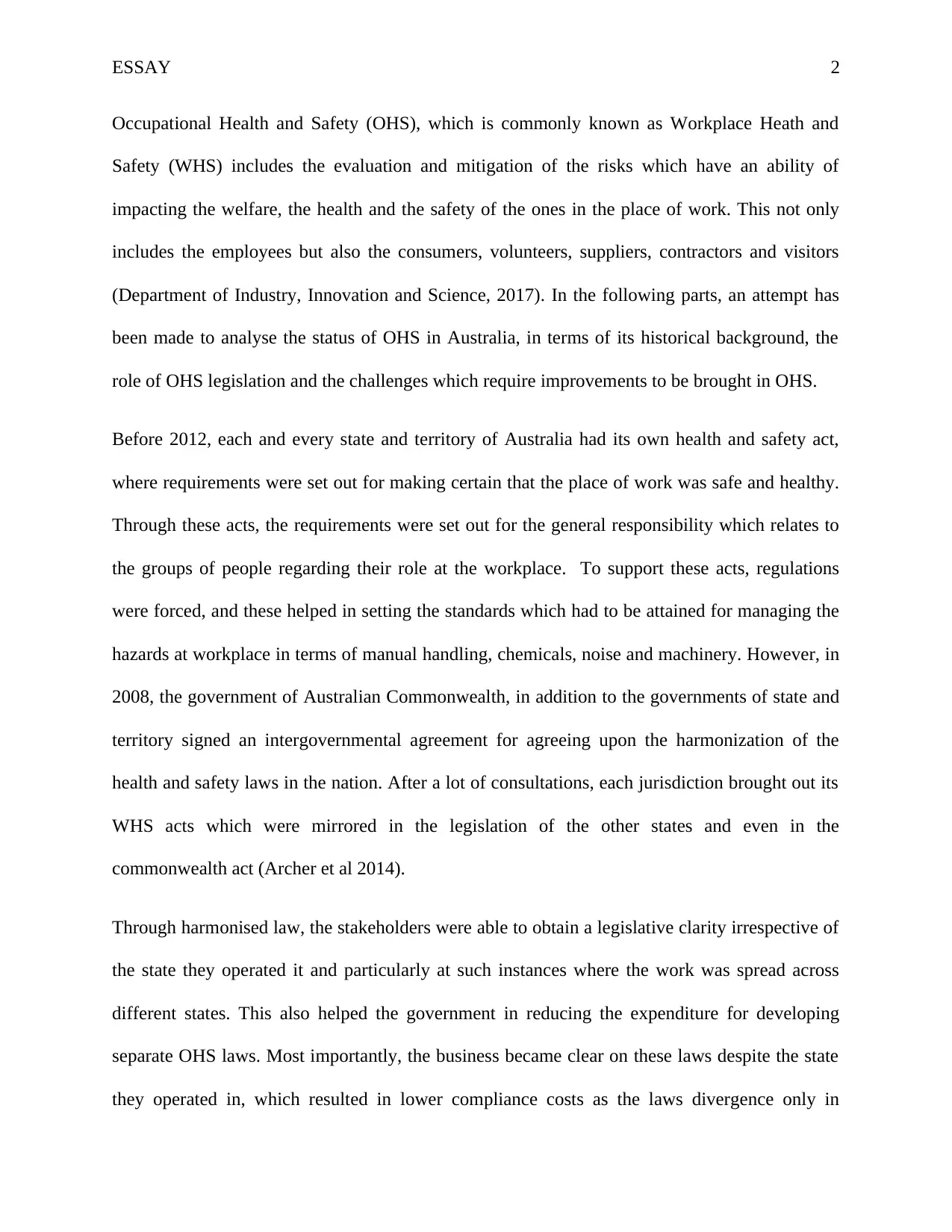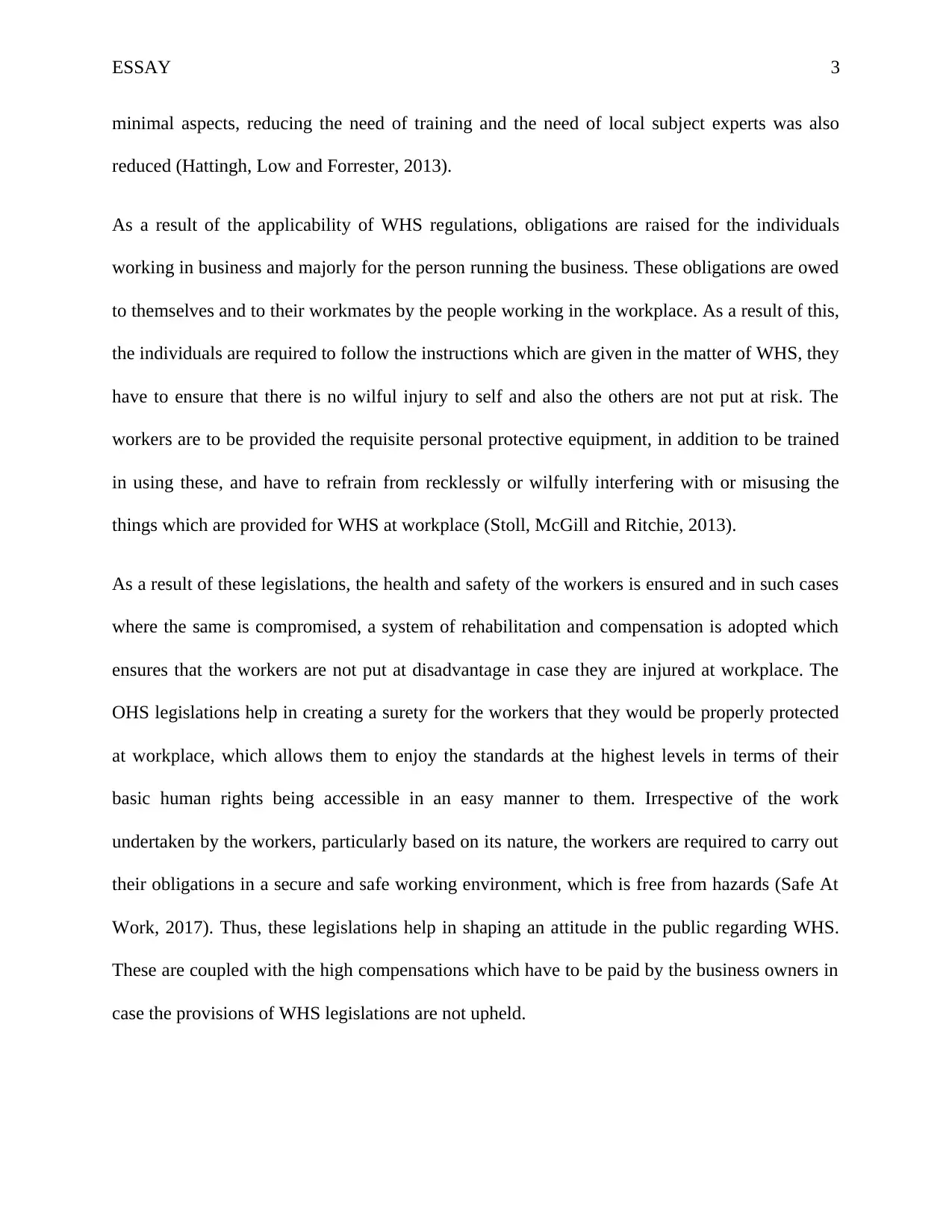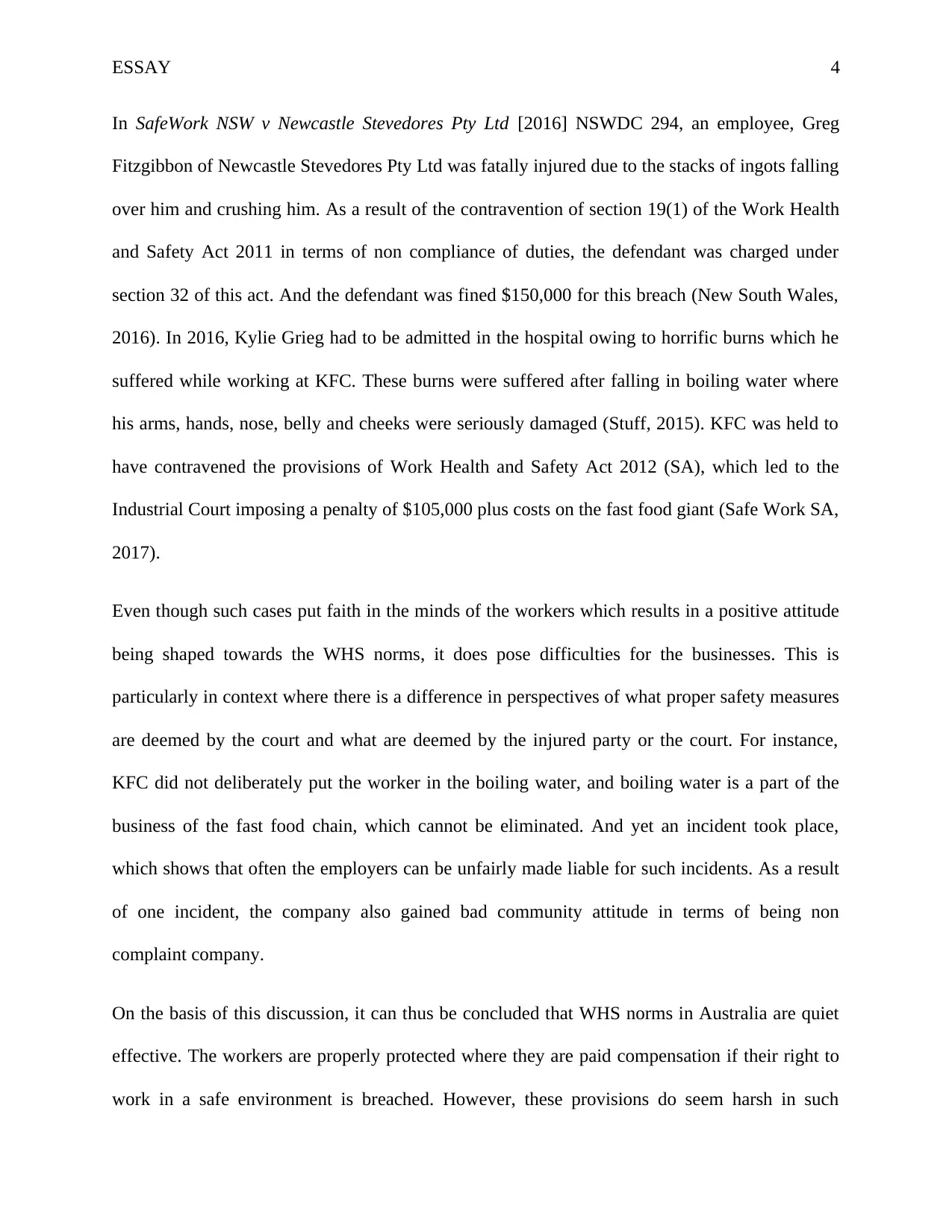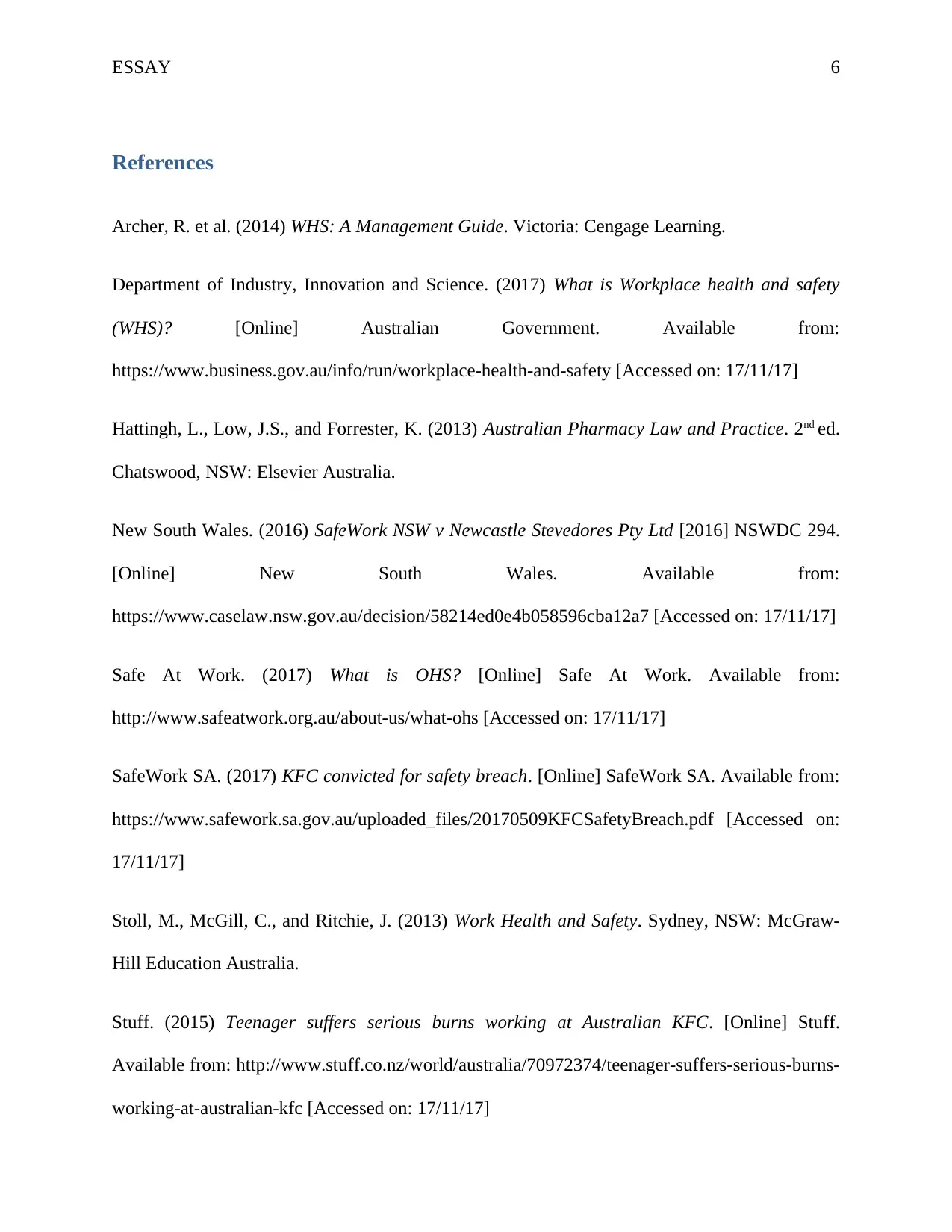Analysis of OHS Legislation and Challenges in Australia
VerifiedAdded on 2020/04/13
|6
|1423
|291
Essay
AI Summary
This essay provides an in-depth analysis of Occupational Health and Safety (OHS) in Australia. It begins by outlining the historical background of OHS, tracing the evolution from state-based acts to the harmonized WHS laws. The essay then explores the role of OHS legislation, emphasizing the obligations of both employers and employees, the importance of providing a safe working environment, and the impact of non-compliance, using case studies such as Newcastle Stevedores Pty Ltd and KFC. The discussion also addresses the challenges faced by businesses in adhering to these regulations, particularly in situations where accidents occur despite safety measures. The essay concludes by highlighting the effectiveness of WHS norms in Australia, while also acknowledging the potential for perceived harshness in certain situations. References to relevant literature and legal cases are included to support the arguments presented.

qwertyuiopasdfghjklzxcvbnmqwertyui
opasdfghjklzxcvbnmqwertyuiopasdfgh
jklzxcvbnmqwertyuiopasdfghjklzxcvb
nmqwertyuiopasdfghjklzxcvbnmqwer
tyuiopasdfghjklzxcvbnmqwertyuiopas
dfghjklzxcvbnmqwertyuiopasdfghjklzx
cvbnmqwertyuiopasdfghjklzxcvbnmq
wertyuiopasdfghjklzxcvbnmqwertyuio
pasdfghjklzxcvbnmqwertyuiopasdfghj
WHS Assignments
Essay
17-Nov-17
(Student Details: )
opasdfghjklzxcvbnmqwertyuiopasdfgh
jklzxcvbnmqwertyuiopasdfghjklzxcvb
nmqwertyuiopasdfghjklzxcvbnmqwer
tyuiopasdfghjklzxcvbnmqwertyuiopas
dfghjklzxcvbnmqwertyuiopasdfghjklzx
cvbnmqwertyuiopasdfghjklzxcvbnmq
wertyuiopasdfghjklzxcvbnmqwertyuio
pasdfghjklzxcvbnmqwertyuiopasdfghj
WHS Assignments
Essay
17-Nov-17
(Student Details: )
Paraphrase This Document
Need a fresh take? Get an instant paraphrase of this document with our AI Paraphraser

ESSAY 2
Occupational Health and Safety (OHS), which is commonly known as Workplace Heath and
Safety (WHS) includes the evaluation and mitigation of the risks which have an ability of
impacting the welfare, the health and the safety of the ones in the place of work. This not only
includes the employees but also the consumers, volunteers, suppliers, contractors and visitors
(Department of Industry, Innovation and Science, 2017). In the following parts, an attempt has
been made to analyse the status of OHS in Australia, in terms of its historical background, the
role of OHS legislation and the challenges which require improvements to be brought in OHS.
Before 2012, each and every state and territory of Australia had its own health and safety act,
where requirements were set out for making certain that the place of work was safe and healthy.
Through these acts, the requirements were set out for the general responsibility which relates to
the groups of people regarding their role at the workplace. To support these acts, regulations
were forced, and these helped in setting the standards which had to be attained for managing the
hazards at workplace in terms of manual handling, chemicals, noise and machinery. However, in
2008, the government of Australian Commonwealth, in addition to the governments of state and
territory signed an intergovernmental agreement for agreeing upon the harmonization of the
health and safety laws in the nation. After a lot of consultations, each jurisdiction brought out its
WHS acts which were mirrored in the legislation of the other states and even in the
commonwealth act (Archer et al 2014).
Through harmonised law, the stakeholders were able to obtain a legislative clarity irrespective of
the state they operated it and particularly at such instances where the work was spread across
different states. This also helped the government in reducing the expenditure for developing
separate OHS laws. Most importantly, the business became clear on these laws despite the state
they operated in, which resulted in lower compliance costs as the laws divergence only in
Occupational Health and Safety (OHS), which is commonly known as Workplace Heath and
Safety (WHS) includes the evaluation and mitigation of the risks which have an ability of
impacting the welfare, the health and the safety of the ones in the place of work. This not only
includes the employees but also the consumers, volunteers, suppliers, contractors and visitors
(Department of Industry, Innovation and Science, 2017). In the following parts, an attempt has
been made to analyse the status of OHS in Australia, in terms of its historical background, the
role of OHS legislation and the challenges which require improvements to be brought in OHS.
Before 2012, each and every state and territory of Australia had its own health and safety act,
where requirements were set out for making certain that the place of work was safe and healthy.
Through these acts, the requirements were set out for the general responsibility which relates to
the groups of people regarding their role at the workplace. To support these acts, regulations
were forced, and these helped in setting the standards which had to be attained for managing the
hazards at workplace in terms of manual handling, chemicals, noise and machinery. However, in
2008, the government of Australian Commonwealth, in addition to the governments of state and
territory signed an intergovernmental agreement for agreeing upon the harmonization of the
health and safety laws in the nation. After a lot of consultations, each jurisdiction brought out its
WHS acts which were mirrored in the legislation of the other states and even in the
commonwealth act (Archer et al 2014).
Through harmonised law, the stakeholders were able to obtain a legislative clarity irrespective of
the state they operated it and particularly at such instances where the work was spread across
different states. This also helped the government in reducing the expenditure for developing
separate OHS laws. Most importantly, the business became clear on these laws despite the state
they operated in, which resulted in lower compliance costs as the laws divergence only in

ESSAY 3
minimal aspects, reducing the need of training and the need of local subject experts was also
reduced (Hattingh, Low and Forrester, 2013).
As a result of the applicability of WHS regulations, obligations are raised for the individuals
working in business and majorly for the person running the business. These obligations are owed
to themselves and to their workmates by the people working in the workplace. As a result of this,
the individuals are required to follow the instructions which are given in the matter of WHS, they
have to ensure that there is no wilful injury to self and also the others are not put at risk. The
workers are to be provided the requisite personal protective equipment, in addition to be trained
in using these, and have to refrain from recklessly or wilfully interfering with or misusing the
things which are provided for WHS at workplace (Stoll, McGill and Ritchie, 2013).
As a result of these legislations, the health and safety of the workers is ensured and in such cases
where the same is compromised, a system of rehabilitation and compensation is adopted which
ensures that the workers are not put at disadvantage in case they are injured at workplace. The
OHS legislations help in creating a surety for the workers that they would be properly protected
at workplace, which allows them to enjoy the standards at the highest levels in terms of their
basic human rights being accessible in an easy manner to them. Irrespective of the work
undertaken by the workers, particularly based on its nature, the workers are required to carry out
their obligations in a secure and safe working environment, which is free from hazards (Safe At
Work, 2017). Thus, these legislations help in shaping an attitude in the public regarding WHS.
These are coupled with the high compensations which have to be paid by the business owners in
case the provisions of WHS legislations are not upheld.
minimal aspects, reducing the need of training and the need of local subject experts was also
reduced (Hattingh, Low and Forrester, 2013).
As a result of the applicability of WHS regulations, obligations are raised for the individuals
working in business and majorly for the person running the business. These obligations are owed
to themselves and to their workmates by the people working in the workplace. As a result of this,
the individuals are required to follow the instructions which are given in the matter of WHS, they
have to ensure that there is no wilful injury to self and also the others are not put at risk. The
workers are to be provided the requisite personal protective equipment, in addition to be trained
in using these, and have to refrain from recklessly or wilfully interfering with or misusing the
things which are provided for WHS at workplace (Stoll, McGill and Ritchie, 2013).
As a result of these legislations, the health and safety of the workers is ensured and in such cases
where the same is compromised, a system of rehabilitation and compensation is adopted which
ensures that the workers are not put at disadvantage in case they are injured at workplace. The
OHS legislations help in creating a surety for the workers that they would be properly protected
at workplace, which allows them to enjoy the standards at the highest levels in terms of their
basic human rights being accessible in an easy manner to them. Irrespective of the work
undertaken by the workers, particularly based on its nature, the workers are required to carry out
their obligations in a secure and safe working environment, which is free from hazards (Safe At
Work, 2017). Thus, these legislations help in shaping an attitude in the public regarding WHS.
These are coupled with the high compensations which have to be paid by the business owners in
case the provisions of WHS legislations are not upheld.
⊘ This is a preview!⊘
Do you want full access?
Subscribe today to unlock all pages.

Trusted by 1+ million students worldwide

ESSAY 4
In SafeWork NSW v Newcastle Stevedores Pty Ltd [2016] NSWDC 294, an employee, Greg
Fitzgibbon of Newcastle Stevedores Pty Ltd was fatally injured due to the stacks of ingots falling
over him and crushing him. As a result of the contravention of section 19(1) of the Work Health
and Safety Act 2011 in terms of non compliance of duties, the defendant was charged under
section 32 of this act. And the defendant was fined $150,000 for this breach (New South Wales,
2016). In 2016, Kylie Grieg had to be admitted in the hospital owing to horrific burns which he
suffered while working at KFC. These burns were suffered after falling in boiling water where
his arms, hands, nose, belly and cheeks were seriously damaged (Stuff, 2015). KFC was held to
have contravened the provisions of Work Health and Safety Act 2012 (SA), which led to the
Industrial Court imposing a penalty of $105,000 plus costs on the fast food giant (Safe Work SA,
2017).
Even though such cases put faith in the minds of the workers which results in a positive attitude
being shaped towards the WHS norms, it does pose difficulties for the businesses. This is
particularly in context where there is a difference in perspectives of what proper safety measures
are deemed by the court and what are deemed by the injured party or the court. For instance,
KFC did not deliberately put the worker in the boiling water, and boiling water is a part of the
business of the fast food chain, which cannot be eliminated. And yet an incident took place,
which shows that often the employers can be unfairly made liable for such incidents. As a result
of one incident, the company also gained bad community attitude in terms of being non
complaint company.
On the basis of this discussion, it can thus be concluded that WHS norms in Australia are quiet
effective. The workers are properly protected where they are paid compensation if their right to
work in a safe environment is breached. However, these provisions do seem harsh in such
In SafeWork NSW v Newcastle Stevedores Pty Ltd [2016] NSWDC 294, an employee, Greg
Fitzgibbon of Newcastle Stevedores Pty Ltd was fatally injured due to the stacks of ingots falling
over him and crushing him. As a result of the contravention of section 19(1) of the Work Health
and Safety Act 2011 in terms of non compliance of duties, the defendant was charged under
section 32 of this act. And the defendant was fined $150,000 for this breach (New South Wales,
2016). In 2016, Kylie Grieg had to be admitted in the hospital owing to horrific burns which he
suffered while working at KFC. These burns were suffered after falling in boiling water where
his arms, hands, nose, belly and cheeks were seriously damaged (Stuff, 2015). KFC was held to
have contravened the provisions of Work Health and Safety Act 2012 (SA), which led to the
Industrial Court imposing a penalty of $105,000 plus costs on the fast food giant (Safe Work SA,
2017).
Even though such cases put faith in the minds of the workers which results in a positive attitude
being shaped towards the WHS norms, it does pose difficulties for the businesses. This is
particularly in context where there is a difference in perspectives of what proper safety measures
are deemed by the court and what are deemed by the injured party or the court. For instance,
KFC did not deliberately put the worker in the boiling water, and boiling water is a part of the
business of the fast food chain, which cannot be eliminated. And yet an incident took place,
which shows that often the employers can be unfairly made liable for such incidents. As a result
of one incident, the company also gained bad community attitude in terms of being non
complaint company.
On the basis of this discussion, it can thus be concluded that WHS norms in Australia are quiet
effective. The workers are properly protected where they are paid compensation if their right to
work in a safe environment is breached. However, these provisions do seem harsh in such
Paraphrase This Document
Need a fresh take? Get an instant paraphrase of this document with our AI Paraphraser

ESSAY 5
situations where even after using the proper safety measures, a worker is injured, for which the
company has to bear the loss in terms of compensation.
situations where even after using the proper safety measures, a worker is injured, for which the
company has to bear the loss in terms of compensation.

ESSAY 6
References
Archer, R. et al. (2014) WHS: A Management Guide. Victoria: Cengage Learning.
Department of Industry, Innovation and Science. (2017) What is Workplace health and safety
(WHS)? [Online] Australian Government. Available from:
https://www.business.gov.au/info/run/workplace-health-and-safety [Accessed on: 17/11/17]
Hattingh, L., Low, J.S., and Forrester, K. (2013) Australian Pharmacy Law and Practice. 2nd ed.
Chatswood, NSW: Elsevier Australia.
New South Wales. (2016) SafeWork NSW v Newcastle Stevedores Pty Ltd [2016] NSWDC 294.
[Online] New South Wales. Available from:
https://www.caselaw.nsw.gov.au/decision/58214ed0e4b058596cba12a7 [Accessed on: 17/11/17]
Safe At Work. (2017) What is OHS? [Online] Safe At Work. Available from:
http://www.safeatwork.org.au/about-us/what-ohs [Accessed on: 17/11/17]
SafeWork SA. (2017) KFC convicted for safety breach. [Online] SafeWork SA. Available from:
https://www.safework.sa.gov.au/uploaded_files/20170509KFCSafetyBreach.pdf [Accessed on:
17/11/17]
Stoll, M., McGill, C., and Ritchie, J. (2013) Work Health and Safety. Sydney, NSW: McGraw-
Hill Education Australia.
Stuff. (2015) Teenager suffers serious burns working at Australian KFC. [Online] Stuff.
Available from: http://www.stuff.co.nz/world/australia/70972374/teenager-suffers-serious-burns-
working-at-australian-kfc [Accessed on: 17/11/17]
References
Archer, R. et al. (2014) WHS: A Management Guide. Victoria: Cengage Learning.
Department of Industry, Innovation and Science. (2017) What is Workplace health and safety
(WHS)? [Online] Australian Government. Available from:
https://www.business.gov.au/info/run/workplace-health-and-safety [Accessed on: 17/11/17]
Hattingh, L., Low, J.S., and Forrester, K. (2013) Australian Pharmacy Law and Practice. 2nd ed.
Chatswood, NSW: Elsevier Australia.
New South Wales. (2016) SafeWork NSW v Newcastle Stevedores Pty Ltd [2016] NSWDC 294.
[Online] New South Wales. Available from:
https://www.caselaw.nsw.gov.au/decision/58214ed0e4b058596cba12a7 [Accessed on: 17/11/17]
Safe At Work. (2017) What is OHS? [Online] Safe At Work. Available from:
http://www.safeatwork.org.au/about-us/what-ohs [Accessed on: 17/11/17]
SafeWork SA. (2017) KFC convicted for safety breach. [Online] SafeWork SA. Available from:
https://www.safework.sa.gov.au/uploaded_files/20170509KFCSafetyBreach.pdf [Accessed on:
17/11/17]
Stoll, M., McGill, C., and Ritchie, J. (2013) Work Health and Safety. Sydney, NSW: McGraw-
Hill Education Australia.
Stuff. (2015) Teenager suffers serious burns working at Australian KFC. [Online] Stuff.
Available from: http://www.stuff.co.nz/world/australia/70972374/teenager-suffers-serious-burns-
working-at-australian-kfc [Accessed on: 17/11/17]
⊘ This is a preview!⊘
Do you want full access?
Subscribe today to unlock all pages.

Trusted by 1+ million students worldwide
1 out of 6
Related Documents
Your All-in-One AI-Powered Toolkit for Academic Success.
+13062052269
info@desklib.com
Available 24*7 on WhatsApp / Email
![[object Object]](/_next/static/media/star-bottom.7253800d.svg)
Unlock your academic potential
Copyright © 2020–2025 A2Z Services. All Rights Reserved. Developed and managed by ZUCOL.




